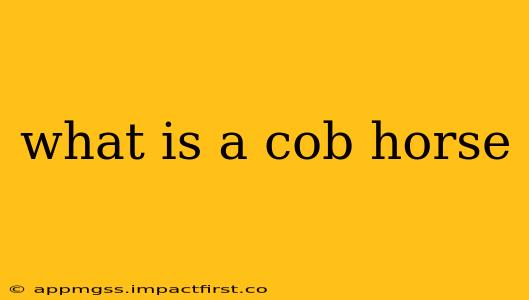The term "cob" doesn't refer to a specific breed of horse, but rather a type or style of horse characterized by its build and temperament. Cob horses are known for their sturdy, compact bodies, their calm dispositions, and their suitability for a wide range of riding styles and disciplines. Think of it less as a breed and more as a description of a horse's conformation and personality. Many different breeds can produce cobs, contributing to the variations you'll see.
What are the physical characteristics of a cob?
Cob horses are typically stocky and powerfully built. They possess:
- A short, strong back: This contributes to their ability to carry weight comfortably.
- Deep chest and well-muscled quarters: Indicative of strength and stamina.
- Short, strong legs: Providing stability and surefootedness.
- Thick, often feathered legs: This is a characteristic often seen, though not universally present, adding to their rugged appearance.
- A dense, weather-resistant coat: A key feature for those living in harsher climates.
- A relatively short, thick neck: Contributing to their overall compact build.
The height of a cob can vary, generally ranging from 12 to 15 hands (48 to 60 inches) high. However, this is not a rigid definition.
What makes a cob horse different from other horse types?
The key difference lies in the cob's combination of strength, stamina, and calm temperament. Unlike the more refined build of some breeds like Thoroughbreds or Arabians, cobs are built for practicality and endurance. While some breeds, like the Welsh Cob, are specifically bred to fit the cob type, many other breeds can produce horses that exhibit cob characteristics.
This makes it challenging to definitively define a cob—it's about the overall impression rather than a strict set of rules. A cob might be a crossbreed inheriting desirable traits from its parent breeds, leading to even more variation.
Are cobs good for beginners?
H2: Are cob horses good for beginner riders?
Yes, cobs are often considered excellent mounts for beginners. Their calm and docile nature makes them forgiving of rider mistakes, and their sturdy build provides a sense of security. However, like any horse, proper training and experienced guidance are essential for safe and enjoyable riding. The gentle temperament is a significant advantage, but it's crucial to remember that individual horse personalities can vary.
What types of riding are cobs suitable for?
H2: What types of riding are cobs suitable for?
Cobs are incredibly versatile and capable of participating in a variety of disciplines, including:
- Hacking: Leisurely rides in the countryside.
- Driving: Pulling carriages or carts.
- Light riding: Gentle trail rides and schooling.
- Showing: Many cob types are shown in breed-specific competitions or general riding classes.
While not typically used for high-intensity disciplines like racing, their strength and stamina make them suitable partners for a diverse range of activities.
What are some common breeds associated with the cob type?
H2: What breeds of horses are considered cobs?
While not a breed itself, several breeds are known for producing horses with cob characteristics:
- Welsh Cob: One of the most recognizable breeds associated with the cob type, they are known for their strength and versatility.
- Connemara Pony: Often exhibiting cob-like characteristics, particularly in size and build.
- Traditional Gypsy Cob: Known for their feathering and calm temperament.
- Dartmoor Pony: A smaller pony breed that can sometimes exhibit cob characteristics.
Many other breeds can produce horses that fit the cob description, highlighting the versatility of the term itself.
This information should provide a clear understanding of what constitutes a cob horse. Remember that it's a description of a type, not a breed, encompassing many different possibilities within a shared set of physical and temperamental traits.
